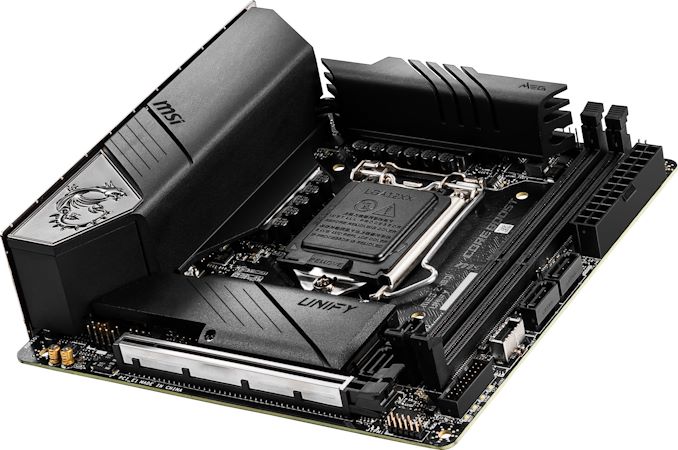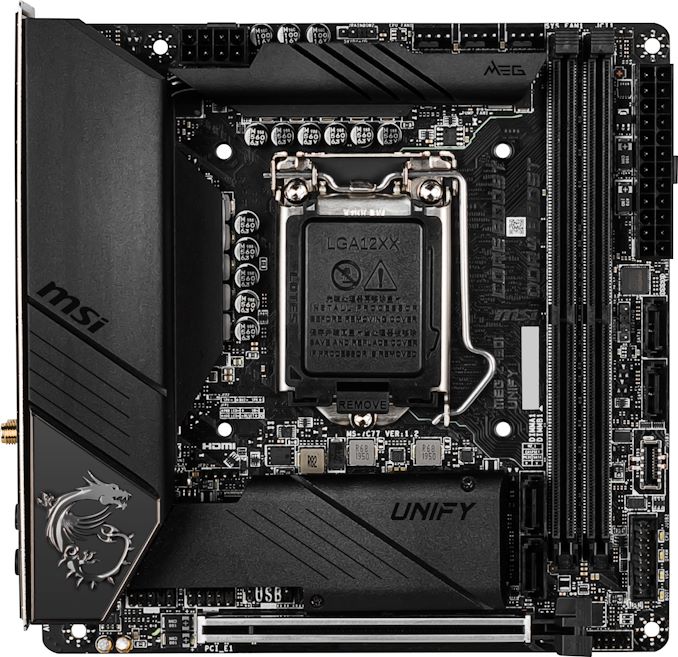MSI Unveils MEG Z490 Unify Series: Unassuming Style
by Gavin Bonshor on May 11, 2020 9:00 AM EST- Posted in
- Motherboards
- Intel
- MSI
- Mini ITX
- ATX
- Z490
- MEG
- Intel 10th Gen
- Z490 Unify
- Z490I Unify

With the release of Intel's 10th generation desktop processors (Comet Lake-S) looming ever closer, MSI has announced a pair of new Z490 models, the MSI MEG Z490 Unify and MSI MEG Z490I Unify. With a clear focus on design, the MEG Z490 Unify and Z490I Unify both carry an all-black aesthetic with no integrated RGB LEDs with some exciting features.
Starting with the MSI MEG Z490 Unify, it follows the ATX form factor and has a wave of features. This includes a solid-looking 16-phase power delivery with Intersil 90 A power stages with are doubled and is controlled by an ISL69269 PWM controller operating in an 8+0 configuration. Some of the main features include three PCIe 3.0 x4 M.2 slots, three full-length PCIe 3.0 slots working at x16, x8/x8, and x8/x8/+4, with two PCIe 3.0 x1 slots. There are six SATA ports with support for RAID 0, 1, 5, and 10 arrays, while the board supports up to 128 GB of DDR4-4800 across its four slots. On the rear panel plenty of high-speed connectivity including a single USB 3.2 G2 20 Gbps Type-C, and three USB 3.2 G2 10 Gbps Type-A ports, as well as a Realtek ALC1220 HD codec handing the boards audio and a Realtek RTL8125BG 2.5 G Ethernet port, and connectors for the Intel AX201 Wi-Fi 6 wireless interface.
The smaller mini-ITX sized MSI MEG Z490I Unify features a 10-layer PCB which is impressive for a board of its size. It has a direct 8-phase power delivery with 90 A power stages, and an Intersil ISL69269 PWM controller regulating the power to the CPU. Looking at the features, it includes dual PCIe 3.0 x4 M.2 slots, four SATA ports, and a single full-length PCIe 3.0 x16 slot, which MSI is stating that it is ready for PCIe 4.0. The rear panel includes a single Thunderbolt 3 Type-C input, with a DisplayPort 1.4 and HDMI video output pairing, and benefits from a Realtek ALC1220 HD audio codec. For networking, there is a single Realtek RTL8125BG 2.5 G Ethernet port, and connectors for the Intel AX201 Wi-Fi 6 wireless interface, which also has support for BT 5.1 devices.
It looks as though MSI enjoy success with its debut of the Unify series on the X570 chipset, and has made the non-RGB themed range a prominent series in its already stacked arsenal. MSI hasn't officially stated when both the MEG Z490 Unify and MEG Z490I Unify will hit retail shelves, with a price of $270 for the mini-ITX model, and $300 for the ATX.
Related Reading
Source: MSI












28 Comments
View All Comments
Hxx - Monday, May 11, 2020 - link
pricing was disclosed during the livestream a few days ago. 299/269 for the ATX/ITX. Amazon/BH have preorders for the ITX version with a 5/20 release like the rest of the boards.gavbon - Monday, May 11, 2020 - link
Thank you, updated.amandakspikes - Monday, May 18, 2020 - link
I’m making more than $75k by just doing very easy and simple online job from home.Last month my friend sister received $94280 from this work by just giving only 2 to 3 hrs a day.Everybody start earning money online. visit for more details… www.iⅭash68.ⅭOⅯOperandi - Monday, May 11, 2020 - link
Aesthetics matter but board designers have to stop covering up the VRM heatsinks with I/O covers. A Barret M99, and F22 look badass because everything on is functional but if you think aesthetics were not a design consideration when they were drawn up you are fooling yourself. Form matters but it should always follow function, motherboard manufactures need to incorporate the board heatsinks as part of the design and stop covering them up and making them stylized blocks of metal.Also, where is mATX? ATX is just stupid.
DanNeely - Monday, May 11, 2020 - link
Looking at MSI's pages, the combined VRM heatsink and IO cover is a functional feature. They've got small fans in the assembly; so by joining the two components they're creating a shroud to make sure the air pulled by the fans has to go through the heatsinks.Operandi - Monday, May 11, 2020 - link
Adding a fan just adds cost and complexity and ouldn't be needed on the ATX and mATX versions if the heatsinks had decent surface area and weren't covered up by the IO shield. Design that's function is compromised for the sake of form is bad design.Hxx - Monday, May 11, 2020 - link
the I/O cove is one big aluminum heatsink with a fan that is pwm controlled. So its just one big chunk of metal. techpowerup posted a preview and took apart the heatsink.Operandi - Monday, May 11, 2020 - link
The IO cover dosn't need to be there, it dosn't do anything. Its just useless cosmetic cladding and things that serve no obvious function look stupid. Drop it and put real heatsinks on that actually do something and you don't need the fan. The board would be cheaper, be more reliable and look better.Hxx - Monday, May 11, 2020 - link
the IO cover is supposed to act as a heatsink hence the aluminum construction. Could they have done a better job with a finned hs? Maybe but at least is not some cheap plastic addon.Operandi - Monday, May 11, 2020 - link
I agree its a lot better than what you see on some other boards and generally speaking this is going in the right direction but it could still be better. I feel like motherboards from 5+ years ago had way better design compared to recent stuff that looks put gaudy design features over functionality. Hopefully this is a sign that priorities are shifting back where they belong.